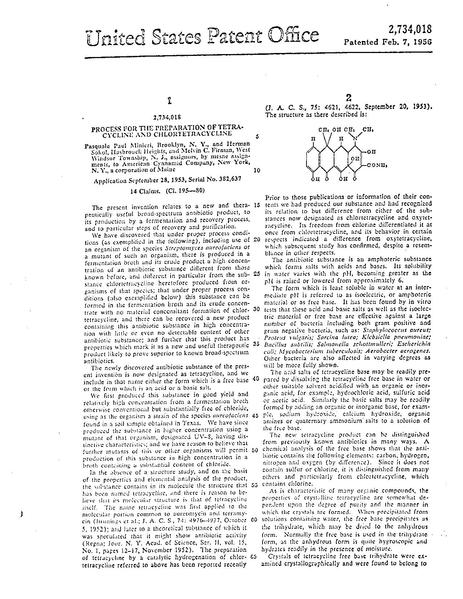Tetracycline (INN) /ËŒtÉ›trəˈsaɪkliËn/ is a broad-spectrum polyketide antibiotic produced by the Streptomyces genus of Actinobacteria, indicated for use against many bacterial infections. It is a protein synthesis inhibitor. It is commonly used to treat acne today, and, more recently, rosacea, and is historically important in reducing the number of deaths from cholera. Tetracycline is marketed under the brand names Sumycin, Tetracyn, and Panmycin, among others. Actisite is a thread-like fiber formulation used in dental applications. It is also used to produce several semisynthetic derivatives, which together are known as the tetracycline antibiotics. The term "tetracycline" is also used to denote the four-ring system of this compound; "tetracyclines" are related substances that contain the same four-ring system.
It is on the World Health Organization's List of Essential Medicines, a list of the most important medication needed in a basic health system.
Medical uses

It is first-line therapy for rocky mountain spotted fever (Rickettsia), Lyme disease (B. burgdorferi), Q fever (Coxiella), psittacosis and lymphogranuloma venereum (Chlamydia), mycoplasma pneumoniae and to eradicate nasal carriage of meningococci. Tetracycline tablets were used in the plague outbreak in India in 1992.
Spectrum of bacterial susceptibility
Tetracyclines have a broad spectrum of antibiotic action. Originally, they possessed some level of bacteriostatic activity against almost all medically relevant aerobic and anaerobic bacterial genera, both Gram-positive and Gram-negative, with a few exceptions, such as Pseudomonas aeruginosa and Proteus spp., which display intrinsic resistance. However, acquired (as opposed to inherent) resistance has proliferated in many pathogenic organisms and greatly eroded the formerly vast versatility of this group of antibiotics. Resistance amongst Staphylococcus spp., Streptococcus spp., Neisseria gonorrhoeae, anaerobes, members of the Enterobacteriaceae and several other previously sensitive organisms is now quite common. Tetracyclines remain especially useful in the management of infections by certain obligately intracellular bacterial pathogens such as Chlamydia, Mycoplasma and Rickettsia. They are also of value in spirochaetal infections, such as syphilis, leptospirosis and Lyme disease. Certain rare or exotic infections, including anthrax, plague and brucellosis, are also susceptible to tetracyclines. These agents also have activity against certain eukaryotic parasites, including those responsible for diseases such as malaria and balantidiasis. The following represents MIC susceptibility data for a few medically significant microorganisms:
- Escherichia coli: 1 μg/ml - >128 μg/ml
- Shigella spp.: 1 μg/ml - 128 μg/ml
Mechanisms of resistance
Bacteria usually acquire resistance to tetracycline from horizontal transfer of a gene that either encodes an efflux pump or a ribosomal protection protein. Efflux pumps actively eject tetracycline from the cell, preventing the buildup of an inhibitory concentration of tetracycline in the cytoplasm. Ribosomal protection proteins interact with the ribosome and dislodge tetracycline from the ribosome, allowing for translation to continue.
Side effects

Use of the tetracycline antibiotics group is problematic; they can:
- Stain developing teeth (even when taken by the mother during pregnancy)
- Discolor permanent teeth (yellow-gray-brown), from infancy and childhood to eight years old
- Be inactivated by Ca2+ ion, so are not to be taken with milk, yogurt, and other dairy products
- Be inactivated by aluminium, iron and zinc, not to be taken at the same time as indigestion remedies (common antacids and over-the-counter heartburn medicines)
- Cause skin photosensitivity, so exposure to the sun or intense light is not recommended
- Cause drug-induced lupus, and hepatitis
- Cause microvesicular fatty liver
- Cause tinnitus
- Interfere with methotrexate by displacing it from the various protein binding sites
- Cause breathing complications, as well as anaphylactic shock, in some individuals
- Affect bone growth of the fetus, so should be avoided during pregnancy
- Fanconi syndrome may result by ingesting expired tetracyclines.
Caution should be exercised in long-term use with breastfeeding. Short-term use is safe; bioavailability in milk is low to nil. In 2010, the FDA added tetracycline to its Adverse Event Reporting System (AERS). The AERS contains a list of medications under investigation by the FDA for potential safety issues. The list is published quarterly and available online. The AERS cites a potential link between the use of tetracycline products and Stevensâ€"Johnson syndrome, toxic epidermal necrolysis and erythema multiforme.
Other uses
Since tetracycline is absorbed into bone, it is used as a marker of bone growth for biopsies in humans. Tetracycline labeling is used to determine the amount of bone growth within a certain period of time, usually a period of approximately 21 days. Tetracycline is incorporated into mineralizing bone and can be detected by its fluorescence. In "double tetracycline labeling", a second dose is given 11â€"14 days after the first dose, and the amount of bone formed during that interval can be calculated by measuring the distance between the two fluorescent labels.
Tetracycline is also used as a biomarker in wildlife to detect consumption of medicine- or vaccine-containing baits.
In genetic engineering, tetracycline is used in transcriptional activation. It is also one of the antibiotics used to treat ulcers caused by bacterial infections. In cancer research at Harvard Medical School, tetracycline has been used to switch off leukemia in genetically altered mice, and to do so reliably, when added to their drinking water.
A technique being developed for the control of the mosquito species Aedes aegypti uses a strain that is genetically modified to require tetracycline to develop beyond the larval stage. Modified males raised in a laboratory will develop normally as they are supplied with this chemical and can be released into the wild. Their subsequent offspring will inherit this trait, but will find no tetracycline in their environment and so will never develop into adults.
Cell culture

Tetracycline is used in cell biology as a selective agent in cell culture systems. It is toxic to prokaryotic and eukaryotic cells and selects for cells harboring the bacterial tetr gene, which encodes a 399-amino-acid, membrane-associated protein. This protein actively exports tetracycline from the cell, rendering cells harboring this gene more resistant to the drug. The yellow crystalline powder can be dissolved in water (20 mg/ml) or ethanol (5 mg/ml), and is routinely used at 10 mg/l in cell culture. In cell culture at 37°C (99°F), it is stable for days, with a half-life of approximately 24 hours.
Mechanism of action
Tetracycline inhibits protein synthesis by blocking the attachment of charged aminoacyl-tRNA to the A site on the ribosome. Tetracycline binds to the 30S subunit of microbial ribosomes. Thus, it prevents introduction of new amino acids to the nascent peptide chain. The action is usually inhibitory and reversible upon withdrawal of the drug. Mammalian cells are less vulnerable to the effect of tetracyclines, despite the fact that tetracycline binds to the small ribosomal subunit of both prokaryotes and eukaryotes (30S and 40S respectively). This is because bacteria actively pump tetracycline into their cytoplasm, even against a concentration gradient, whereas mammalian cells do not. This accounts for the relatively small off-site effect of tetracycline on human cells.
History
The tetracyclines, a large family of antibiotics, were discovered as natural products by Benjamin Minge Duggar in 1945 and first prescribed in 1948. Under Yellapragada Subbarow, Benjamin Duggar made his discovery of the first tetracycline antibiotic, chlorotetracycline (Aureomycin), at Lederle Laboratories in 1945.
In 1950, Harvard University professor Robert Burns Woodward determined the chemical structure of the related substance, oxytetracycline (Terramycin); the patent protection for its fermentation and production was also first issued in 1950. A research team of eight scientists (K.J. Brunings, Francis A. Hochstein, Frederick J. Pilgrim C.R. Stephens, Lloyd Hillyard Conover, Abraham Bavley, Richard Pasternack, and Peter P. Regna) at Pfizer, in collaboration with Woodward, participated in the two-year research leading to the discovery.
Pfizer was of the view that it deserved the right to a patent on tetracycline and filed its Conover application in October 1952. Cyanamid filed its Boothe-Morton application for similar rights in March 1953, while Heyden Chemicals filed its Minieri application in September 1953, named after scientist P. Paul Minieri, to obtain a patent on tetracycline and its fermentation process. This resulted in tetracycline litigation in which the winner would have to prove beyond reasonable doubt of priority invention and tetracycline’s natural state.
Nubian mummies studied in the 1990s were found to contain significant levels of tetracycline; the beer brewed at the time could have been the source. Tetracycline sparked the development of many chemically altered antibiotics, so has proved to be one of the most important discoveries made in the field of antibiotics. It is used to treat many Gram-positive and Gram-negative bacteria. Like some other antibiotics, it is also used in the treatment of acne.
Notes
External links
- Tetracycline bound to proteins in the PDB




0 komentar :
Posting Komentar